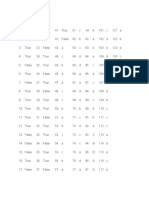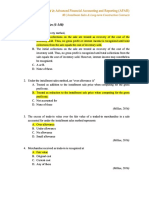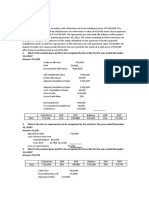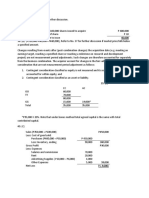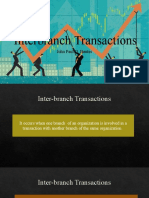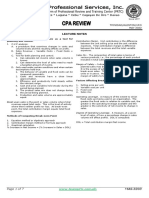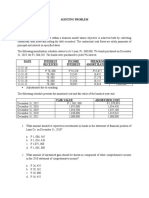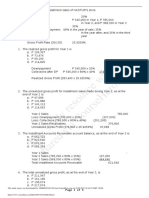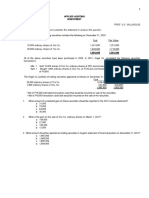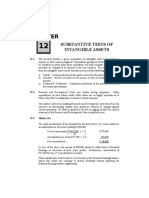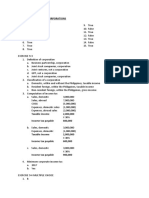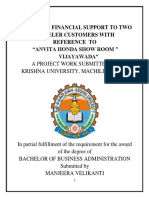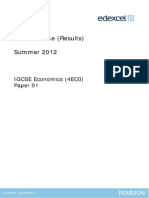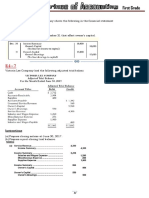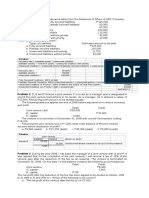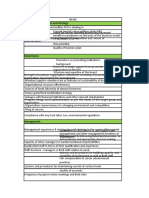Chapter 9
Problem I
1. Jollibee has substantially performed all material services, the refund period has expired,
and the collectibility of the note is reasonably assured. Jollibee recognizes revenue as
follows:
Cash..
Notes receivable.
Franchise revenue..
240,000
600,000
840,000
2. The refund period has expired and the collectibility of the note is reasonably
assured, but Jollibee has not substantially performed all material services. Jollibee
does not recognize revenue, but instead recognizes a liability as follows:
Cash..
Notes receivable.
Unearned franchise revenue..
240,000
600,000
840,000
Franchisor will recognize the unearned franchise fees as revenue when it has performed
all material services, the adjusting entry to record the revenue then would be:
Unearned franchise revenue...
Franchise revenue..
840,000
840,000
3. Jollibee has substantially performed all services and the collectibility of the note is
reasonably assured, but the refund period has not expired. Jollibee does not recognize
revenue, but instead recognizes a liability as follows:
Cash..
Notes receivable.
Unearned franchise revenue..
240,000
600,000
840,000
The franchisor will recognize the unearned franchise fees as revenue when the refund
period expires, the adjusting entry to record the revenue then would be:
Unearned franchise revenue...
Franchise revenue...
840,000
840,000
4. Jollibee has substantially performed all services and the refund period has expired, but the
collectibility of the note is not reasonably assured. Jollibee recognizes revenue by the
installment or cost recovery method. If we assume that Jollibee uses the installment
method, it recognizes revenue of P240,000 as follows:
Cash..
Notes receivable.
Franchise revenue..
Unearned franchise revenue
240,000
600,000
240,000
600,000
The franchisor is using the installment method, it recognizes the unearned franchise fees as
revenue in the amount of P120,000 each year as it receives cash assuming there is no cost
�of franchise, the entry would be as follows:
Unearned franchise revenue
Franchise revenue..
120,000
120,000
This revenue recognition may be true only in the event there is no cost of franchise at all.
On the other hand, it may be somewhat misleading since under the installment sales
method; gross profit is earned or realized thru collections.
5. The refund period has expired, but Jollibee has not substantially performed all services
and there is no basis for estimating the collectibility of the note. Jollibee does not
recognize the note as an asset. Instead, it uses a form of the deposit method. For
example, suppose Jollibee has developed an entirely new product whose success is
uncertain and the franchisee will pay the note from the cash flows from the sale of the
product, if any. Jollibee records the initial transaction as follows:
Cash..
Unearned franchise revenue..
240,000
240,000
The franchisor may recognize the unearned franchise fees as revenue under the
accrual method in the normal manner at the completion of the services to be
performed (if collectibility is reasonably assured), the adjusting entry to record the
revenue then would be:
Unearned franchise revenue...
Franchise revenue...
240,000
240,000
Alternatively, it may recognize revenue under the installment method if it has no basis for
estimating the collectibility of the note.
6. Now assume that Jollibee has earned only P360,000 from providing initial services, with
the balance being a down payment for continuing services. If the refund period has
expired and the collectibility of the note is reasonably assured, Jollibee recognizes
revenue of P360,000 as follows:
Cash..
240,000
Notes receivable.
600,000
Franchise revenue..
360,000
Unearned franchise revenue..
480,000
The franchisor recognizes the unearned franchise revenue of P480,000 as revenue when it
performs the continuing services, the adjusting entry to record the revenue then would
be:
Unearned franchise revenue...
Franchise revenue...
480,000
480,000
In all these cases except the fifth, the franchisor accounts for the collection of interest
and principal on the note receivable in the usual manner. In the fifth situation, it does not
recognize the note and revenue until a future event occurs. In addition, the franchisor
accounts for its costs in the same way as its revenue recognition. That is, if it defers
revenue, then it defers the related cost of goods sold. Then, when it recognizes rev enue, it
�matches the cost of goods sold against the revenues. The franchisee accounts for its
payments as an intangible asset.
Sometimes the franchisor collects the initial franchise fee far in advance of performing its
services. At other times collection of part of the initial franchise fee is deferred until the
franchise is operating successfully.
Problem II
1.
Cash .........................................
Unearned Franchise Fee .....................
2.
Cash .........................................
Note Receivable ..............................
Unearned I.I. or Discount on Note Receivable
Revenue from Franchise Fee .................
[P{75,000 + (P30,000 x 3.0373)] = P116,119
(Table IV n = 4, i = 12%)
3.
Cash .........................................
Note Receivable ..............................
Unearned I.I. or Discount on Note Receivable
Revenue from Franchise Fee .................
Unearned Franchise Fee .....................
75,000
75,000
75,000
120,000
28,881
166,119
75,000
120,000
28,881
75,000
91,119
Problem III
1. If there is a reasonable expectation that the down payment may be refunded and
substantial future services remain to be performed by Pizza, Inc., the entry should be:
Cash..
Notes receivable.
Unearned interest income (or Discount on notes receivable)
Unearned franchise revenue..
120,000.00
480,000.00
80,583.20
419,416,80
2. If the probability of refunding the initial franchise fee is extremely low, the amount of future
services to be provided to the franchisee is minimal, collectibility of the note is reasonably
assured, and substantial performance has occurred, the entry should be:
Cash..
Notes receivable.
Unearned interest income (or Discount on notes receivable)
Franchise revenue..
3.
120,000.00
480,000.00
96,699.84
503,300.16
If the initial down payment is not refundable, represents a fair measure of the services
already provided, with a significant amount of services still to be performed by the franchisor
in future periods, and collectibility of the note is reasonably assured, the entry should be:
Cash..
Notes receivable.
Unearned interest income (or Discount on notes receivable)
Franchise revenue..
Unearned franchise revenue
120,000.00
480,000.00
96,699.84
120,000.00
383,300.16
4. If the initial down payment is not refundable and no future services are required by the
franchisor, but collection of the note is so uncertain that recognition of the note as an asset is
unwarranted, the entry should be:
�Cash..
Franchise revenue..
120,000.00
120,000.00
Where the collection of the note is extremely uncertain, revenue thru gross profit is
recognized by means of cash collection using the cost recovery method.
5.
If the initial down payment is refundable or substantial services are yet to be performed, but
collection of the note is so uncertain that recognition of the note as an asset is unwarranted,
the entry should be:
Cash..
Unearned franchise revenue..
120,000
120,000
Where the collection of the note is extremely uncertain, revenue thru gross profit is
recognized by means of cash collection using the cost recovery method.
Problem IV
1. If the down payment is refundable, and no services have been rendered at the time the
arrangement is made, and collection on the note is reasonably certain, the entry should be:
Cash..
Notes receivable.
Unearned interest income (or Discount on notes receivable)
Unearned franchise revenue..
120,000.00
180,000.00
37,354.50
262,645.50
2. Initial services are determined to be substantially performed, the refund period has expired
and the collection of the note is reasonably assured, the full accrual method would be used.
Assume that substantial performance of the initial services costs P52,529.1 the entry should be:
Cash..
Notes receivable.
Unearned interest income (or Discount on notes receivable)
Franchise revenue..
120,000.00
180,000.00
Cost of franchise revenue
Cash, etc
52,529.10
37,354.50
262,645.50
52,529.10
Few months after, the collectibility of the note becomes doubtful or no reasonable assurance,
the installment sales method could be used as a general rule. In addition to the entries
above, following entries would be required:
a. To set-up cost of franchise:
No entry required, already set-up previously.
b. To defer gross profit on franchise:
Franchise revenue
Cost of franchise revenue
Deferred gross profit on franchise
262,645.50
52,529.10
210,116.40
c. Adjustments to recognize gross profit on franchise:
Deferred gross profit on franchise
Realized gross profit on franchise
Franchise revenue..
96,000.00
96,000.00
262,645.5
�Less: Cost of franchise revenue
Gross profit..
Gross profit rate (210,116.4/262,645.5)
Collections as to principal.
Multiplied by: Gross profit rate.
Realized gross profit on franchise..
52,529.1
210,116.4
80%
P120,000.00
80%
P 96,000.00
Problem V
If we assume that ECHI, whose fiscal year ends on December 31, secures the lease and the
permits on February 1, 20x5, and operations commence at that time, the following journal
entries would be appropriate:
July 1, 20x3:
Cash..
Notes receivable.
Unearned franchise revenue..
120,000
480,000
600,000
Deferral of revenue recognition is required when substantial performance" of franchisor
services has not been completed. It would call for deferral of revenue recognition until
evidence of service performance was available. The best evidence, of course, would be the
commencement of operations of the franchise outlet and at this point in time, revenue is
recognized.
During 20x3:
Deferred cost of franchise revenue.
Cash....
360,000
360,000
December 31, 20x3:
Interest receivable (P480,000 x 14% x 6/12)..
Cash....
33,600
33,600
February 1, 20x4:
Unearned franchise revenue..
Franchise revenue..
600,000
600,000
Cost of franchise revenue..
Deferred cost of franchise revenue..
360,000
360,000
Problem VI
Reasonably Assured
January 1, 20x4
Cash..
Notes receivable.
Unearned franchise revenue.
1,500,000
4,500,000
No reasonable
assurance
1,500,000
4,500,000
6,000,000
6,000,000
Receipt of initial franchise fee.
Conditions to be met:
Services
Period of refund
Collectibility
Cash
No
Yes
Notes
No
Yes
Reasonably
assured
Cash
No
Yes
Notes
No
Yes
No
reasonable
assurance
�1/1/20x4 Balance
Status
December 31, 20x4
Cash..
Notes receivable.
Interest income (P3,750,000 x 10%)
1,500,000
Liability
4,500,000
Liability
1,575,000
1,500,000
Liability
4,500,000
Liability
1,575,000
1,125,000
450,000
1,125,500
450,000
Annual collection.
Deferred cost of franchise
Cash
1,800,000
1,800,000
1,800,000
1,800,000
To defer cost of franchise since substantial
services had not been performed.
Operating expenses
Cash
120,000
120,000
120,000
120,000
To record expenses.
Adjustments:
Cost of franchise
Deferred cost of franchise
1,800,000
1,800,000
To recognize cost of franchise.
Unearned franchise revenue.
Franchise revenue
6,000,000
6,000,000
To recognize franchise revenue based on the
following analysis:
Conditions to be met:
Services
Period of refund
Collectibility
1/1/20x4 Balance..
12/31/20x4: Collection as to principal
12/31/20x4 Balance
Status
Cash
Yes
Yes
1,500,000
1,125,000
2,625,000
Revenue
Notes
Yes
Yes
Reasonably
assured
4,500,000
(1,125,000)
2,625,000
Revenue
Adjustments (Installment sales method)
a. To set-up cost of franchise:
No entry*
b. To set-up deferred gross profit
Unearned franchise revenue
Deferred cost of franchise revenue
Deferred gross profit
6,000,000
1,800,000
4,200,000
*There are different options on this matter, an entry may be made to set-up cost of franchise and eventually it will be
closed to set-up deferred gross profit. Regardless of the option, the objective is to set-up deferred gross profit. Refer to
Illustration 9-6 for alternative treatment to set-up cost of franchise.
Conditions to be met:
Services
Period of refund
Collectibility
1/1/20x4 Balance..
12/31/20x4: Collection as to principal
12/31/20x4 Balance
Cash
Yes
Yes
1,500,000
1,125,000
2,625,000
Notes
Yes
Yes
No
reasonabe
assurance
4,500,000
(1,125,000)
2,625,000
�Status
Revenue
I/S Method
c. To recognize realized gross profit on
franchise:
Deferred gross profit
Realized gross profit on franchise
Liability
1,837,500
1,837,500
Collections principal x gross profit rate
P2,625,000 x (6,000 1,800)/6,000 = P1,837,500
2.
Reasonably Assured
Income Statement, 12/31/20x4:
Franchise revenue (accrual method)*
Less: Cost of franchise (accrual method)*
Gross profit on regular franchise
(accrual)*
Add: Gross profit on franchise (installment
sales method)
Gross profit on franchise
Less: Operating expenses
Add: Interest income..
Net income.
No reasonable
assurance
P6,000,000
1,800,000
0
0
P4,200,000
-0P4,200,000
120,000
P4,080,000
450,000
P4,530,000
*1,837,500
P1,837,500
120,000
P1,717,500
450,000
P2,167,500
Problem VII
1.
Reasonably Assured
January 1, 20x4
Cash..
Notes receivable.
Unearned interest income*
Unearned franchise revenue.
1,440,000
3,840,000
No reasonable
assurance
1,440,000
3,840,000
796,896
4,483,104
796,896
4,483,104
Receipt of initial franchise fee.
Conditions to be met:
Services**
Period of refund until date of
Opening
Collectibility
1/1/20x4 Balance
Status
Cash
No
Notes (PV)
No
Cash
No
Notes (PV)
No
No
No
Reasonably
assured
No
1,440,000
Liability
3,043,104***
Liability
1,440,000
Liability
No
No
reasonable
assurance
3,043,104***
Liability
*Unearned interest income or discount on notes receivable: P3,840,000 P3,043,104 = P796,896.
* *Services had been substantially performed only on the date of opening which is December 8. Revenue is deferred and
subsequent direct cost of franchise should also be deferred.
***P960,000 x 3.1699 = P2,535,920
February 2, 20x4:
Deferred cost of franchise
Cash
To defer cost of franchise since substantial
services had not been performed.
144,931.20
144,931.20
144,931.20
144,931.20
�June 13, 20x4:
General expenses
Cash
60,000
60,000
60,000
60,000
To record expenses.
August 8, 20x4:
Deferred cost of franchise
Cash
360,000
360,000
360,000
360,000
To defer cost of franchise since substantial
services had not been performed.
November 2, 20x4:
Deferred cost of franchise
Cash
840,000
840,000
840,000
840,000
To defer cost of franchise since substantial
services had not been performed.
November 2, 20x4:
Substantial completion of services.
December 31, 20x4:
Cash..
Notes receivable
960,000
960,000
960,000
960,000
Annual collections.
Adjustments:
Unearned interest income
Interest income
To recognize interest income thru
amortization as follows:
10% x P3,043,104 = P304,310.4.
Cost of franchise
Deferred cost of franchise
304,310.40
304,310.40
304,310.40
1,344,931.20
1,344,931.20
To recognize cost of franchise.
Unearned franchise revenue.
Franchise revenue
4,438,1040
4,438,1040
To recognize franchise revenue based on the
following analysis:
Conditions to be met:
Services**
Period of refund outlet already
opened.
Collectibility
1/1/20x4 Balance
12/31/20x4:
Collection..... . P960,000
Less: Interest collection
304,310.40
Collection Principal.P655,689.60
Status
Adjustments (Installment sales method)
a. To set-up cost of franchise:
Cost of franchise revenue..
Cash
Yes
Notes (PV)
Yes
Yes
Yes
Reasonably
assured
4,438,104
1,440,000
655,689.60
2,095,689.60
Revenue
( 655,689.60)
2,387,414.40
Revenue
1,344,931.20
304,310.40
�Deferred cost of franchise revenue
1,344,931.20
b. To set-up deferred gross profit:
Unearned franchise revenue
Cost of franchise revenue
Deferred gross profit
3,483,104
1,344,931.20
2,138,172.80
*There are different options on this matter, an entry may be made to set-up cost of franchise and eventually it will be
closed to set-up deferred gross profit. Regardless of the option, the objective is to set-up deferred gross profit. Refer to
Illustration 9-5 for alternative treatment to set-up cost of franchise.
Conditions to be met:
Services**
Period of refund outlet already
opened.
Collectibility
1/1/20x4 Balance
12/31/20x4:
Collection..... . P960,000
Less: Interest collection 304,310.40
Collection Principal.P655,689.60
Cash
Yes
Notes (PV)
Yes
Yes
Yes
No
reasonable
assurance
304,104
1,440,000
655,689.60
2,095,689.60
Revenue
I/S Method
Status
c. To recognize realized gross profit on
franchise:
Deferred gross profit
Realized gross profit on franchise
( 655,689.60)
2,387,414.4
Liability
1,466,983.20
1,466,983.20
Collections principal x gross profit rate
P2,095,689.60 x (4,483,104 1,344,931.20)/4,483,104 = P1,466,983.20
2.
Reasonably Assured
Income Statement, 12/31/20x4:
Franchise revenue (accrual method)*
Less: Cost of franchise (accrual method)*
Gross profit on regular franchise
(accrual)*
Add: Gross profit on franchise (installment
sales method)
Gross profit on franchise
Less: Operating expenses
Add: Interest income..
Net income.
No reasonable
assurance
P 4,471,1040
0
0
1,344,931.20
P3,138,172.8
-0P3,138,172.8
60,000
P3,078,172.8
*1,466,983.20
P1,466,983.20
60,000
P1,406,983.20
304,310.40
P3,382,483.20
304,310.40
P1,771,293.60
*Note: This item represents regular franchise sales-type transaction. If the collectibility of the fee
(note receivable) is reasonably assured, the permissible method to be applied should be the
accrual method. It should be observed that in the event, there is cost of franchise and the
installment sales method is used, the concept of revenue recognition does literally apply to
franchise revenue but to the recognition of realized gross profit on franchise thru collections as to
principal multiplied by gross profit rate.
Alternatively, computation of interest and principal collections are as follows:
�Date
1/03/20x4
1/03/20x4
12/31/20x4
Total
Collection
Interest (10% of
Unpaid Balance)
Principal
1,440,000
960,000
2,400,000
-0304,310.40
304,310.40
1,440,000
655,689.60
2,095,689.60
Unpaid Balance
4,483,104
3,043,104
2,387,414.40
Problem VIII
1. The fee is earned for providing continuing services:
Cash or Accounts receivable
Franchise revenue continuing franchise fee
108,000
108,000
2. If P10,000 of the fee is for national advertising:
Cash or Accounts receivable
Franchise revenue continuing franchise fee
Unearned franchise revenue continuing franchise fee
108,000
96,000
12,000
The franchisor recognizes the unearned franchise fees as revenue when it performs the
advertising services and also records the costs as expenses, the entries should be:
Advertising expenses
Cash, etc..
Unearned franchise revenue continuing franchise fee
Franchise revenue continuing franchise fee
xxx
xxx
12,000
12,000
Problem IX
March 20:
Cash
Notes receivable
Unearned franchise fee
5,000
20,000
25,000
June 15:
Unearned franchise revenue
Franchise revenue
25,000
25,000
July 15:
Cash
Service revenue
500
500
Problem X
Cash or Accounts receivable
Franchise revenue supplies sales..
Cost of franchise supplies sales
Supplies inventory.
117,600
117,600
90,000
90,000
Problem XI
Cash.
Notes receivable (P108,000 P21,600)
Unearned interest income (P86,400 P69,978)
Franchise revenue (P21,600 + 69,978 P4,800*)
Unearned franchise revenue equipment sale*
21,600
86,400
16,422
86,778
4,800
�All the criteria to recognize initial franchise fee as revenue was met, except that an amount of
P4,800 equivalent to indicated profit (P24,000, selling price less P19,200 option price) will be
deferred.
When the franchisee subsequently purchases the equipment, the entries are as follows:
Cash or Accounts receivable
Unearned franchise revenue equipment sale
Franchise revenue equipment sale..
19,200
4,800
Cost of franchise - equipment sale.
Equipment inventory.
19,200
24,000
19,200
Problem XII
April 1, 20x4:
Cash.
Notes receivable
Franchise revenue (P21,600 + P86,400 P4,800*)
December 31, 20x4:
Franchise revenue initial franchise fee
Interest income (P192,000 x 8% x 9/12)
Cash (P153,600 P11,520).
Notes receivable
Gain or revenue from repossessed franchise
288,000
192,000
480,000
480,000
11,520
142,080
192,000
134,400
Problem XIII
Cash
Notes receivable
Deferred franchise purchase option liability.
72,000
360,000
Deferred cost of franchise revenue
Cash, etc
288,000
Investment..
Deferred franchise purchase option liability.
Deferred cost of franchise revenue
Cash, etc
120,000
432,000
432,000
288,000
Multiple Choice Problems
1. a following conditions should be observed to recognize revenue:
Services none
Period of Refund expired
Collectibility of the note reasonably assured
There was failure on one condition; therefore, no revenue should be recognized.
2. d following conditions should be observed to recognize revenue:
Services Performed yes
Period of Refund not expired / still refundable
Collectibility of the note reasonably assured
There was failure on one condition; therefore, no revenue should be recognized.
288,000
264,000
�3. a - following conditions should be observed to recognize revenue:
Services Performed none
Period of Refund expired
Collectibility of the note very uncertain or extremely uncertain.
There was failure on one condition; therefore, no revenue should be recognized. Since, the
collectibility of the note is extremely uncertain recognition of the note as an asset in
unwarranted (or should not be recorded).
4. d the problem already indicated that P300,000 is earned, therefore the remaining balance
of P400,000 (P700,000 P300,000 is considered as unearned revenue.
5. a
Cash
Notes receivable
Unearned franchise fee
6,000
30,000
Unearned franchise fee
Franchise fee revenue
36,000
Cash
Notes receivable
Franchise fee revenue
6,000
30,000
36,000
6. b
36,000
7. a
36,000
8. b
9. b
10. d
11. d the franchise fee revenue should be zero, since no substantial performance of services
had been performed (and the down payment is still refundable).
12. b
In this problem, since there is doubtful of collection, it is safely assumed to used installment
method. Therefore, the realized gross profit would be:
Collections in 20x4..P 200,000
x: Gross profit rate [100% - (P150,000/P500,000)].
70%
Realized gross profit in 20x4. P 140,000
Revenue Analysis:
Cash
N/R
Services
Yes
Yes
Period of Refund
Yes
Yes
Collectibility
No Reas.
Assured
200,000
300,000
Status
Rev I/S Method
Liability
13. d
In this problem, full accrual method is used to recognized the initial franchise fee of
Initial Franchise Fee:
Services
Cash
Yes
Notes Receivable
Yes
�Period of Refund
Collectibility
Status
Yes
P20,000
Revenue
Yes
Reasonably Assured
P80,000
Revenue
Substantial performance of services has been rendered because commencement of
operations by the franchisee shall be presumed to be the earliest point of which substantial
performance has occurred, unless it can be demonstrated that substantial performance of
all obligations, including services rendered voluntarily, has occurred before that time.
Period of refunding the initial franchise fee and collectibility of the notes is not anymore a
problem (they depend on the profitability of its first year of operations) because the result
of operations in the first year is profitable. Therefore, the initial franchise fee of P100,000
(P20,000 + P P80,000) is considered as revenue, and a continuing franchise fee of P5,000
(1% x P500,000) should be also be recognized as revenue continuing fanchise.
Therefore, the earned franchise fee amounted to P105,000 (P100,000 initial plus P5,000
continuing).
14. a
Initial franchisee revenue (since all services had been performed
and assumed that period of refunding already expired).. P100,000
Add: Continuing franchise revenue (5% x P800,000) 40,000
Total Revenue from franchise. P140,000
15. d
There is already substantial performance of services rendered since, the franchise outlet
started operations and it is assumed that period of refund has expired.
The continuing franchise fee is recognized also as revenue since it is earned at the time it
was received.
The net income would be:
Franchise Revenue:
Initial Franchise Fee:
Down payment P 30,000
PV of installment (P10,000 x 1.7355).
17,355 P47,355
Continuing Franchise Fee (5% x P500,000)
25,000
Total Franchise Revenue
P72,355
Add: Interest Income (10% x P17,355)
1,735
Total Revenue/Net Income
P74,090
16. a
All conditions that initial franchise fee be recognized as revenue had been met as follows:
Revenue Analysis for IFF
Cash
N/R
Services
Yes
Yes
Period of Refund
Yes
Yes
(note)
Collectibility
Reas. Assured
200,000
300,000
Status
Revenue
Revenue
�The Net Income then would be as follows:
Franchise Revenue..P 500,000
Less: Cost of Franchise 150,000
Net IncomeP 350,000
17. d
In this problem, full accrual method is used to recognized the initial franchise fee of
P100,000 analyze as follows:
Revenue Analysis for IFF
Cash
N/R
Services
Yes
Yes
Period of Refund
Yes
Yes
(note)
Collectibility
Reas. Assured
20,000
80,000
Status
Revenue
Revenue
Note: Period of refunding the initial franchise fee was presumed to have been expired
since the business operates profitably in its first year of operation.
Continuing Franchise Fee: Considered revenue the moment continuing services had been
rendered amounted to P5,000 (1% x P500,000).
Initial Franchise FeeP 100,000
Continuing franchise fee.
5,000
Total P 105,000
Less: Indirect cost of franchise
15,000
Net incomeP 90,000
18. d
Revenue = P400,000
Interest income = P
P9,600
Cash = P128,000 P9,600 = P118,400
Repossession revenue: P240,000 P128,000 = P112,000.
19. c
Cash = P560,000 + P48,000 = P608,000
Franchise Fee Revenue = P560,000
Unearned Franchise Fees = P
P9,600
Revenue from Continuing Franchise Fees = P48,000 P9,600 = P38,400.
20. b - P200,000 + P545,872 P24,000 = P721,872.
21. b
Franchisee frequently purchases all of the equipment, products, and supplies from the franchisor.
The franchisor would account for these sales as if, it would be a product sales. Sometimes,
however, the franchise agreement grants the franchisee the right to make bargain purchases of
equipment or supplies after the initial franchise fee is paid. If the bargain price is lower that the
normal selling price of the same product or it does not provide the franchisor the reasonable profit,
then, a portion of the initial franchise fee should be deferred. The deferred portion would be
accounted for as adjustment of the selling price when the franchisee subsequently purchases the
equipment or supplies. Therefore, the amount of revenue would be P90,234 computed as follows:
Cash
Notes Receivable
�Services
Period of Refund
Collectibility
Yes
Yes
P25,000
Revenue
Status
Yes
Yes
Reasonably Assured
P68,234
Revenue except
P3,000 reasonable
profit on sale of
equipment
The revenue from franchise would be:
Cash P 25,000
PV of Note..P68,234
Less: Reasonable profit on sale of
Equipment P15,000 P12,000). 3,000
65,234
P 90,234
Incidentally, the entries would be:
Upon receipt of IFF:
Cash 25,000
Notes Receivable 90,000
Unearned Interest Income (P90,000 P68,234).
21,766
Franchise Revenue.
90,234
Unearned Franchise Revenue.
3,000
If equipment was sold:
Cash or Accounts Receivable 12,000
Unearned Franchise Revenue 3,000
Franchise Revenue Equipment
15,000
Cost of Sales equipment 12,000
Equipment Inventory..
12,000
22. b
Cash
No
No
Services
Period of Refund
Collectibility
P25,000
Liability
Status
Theories
1. True
2. False
3. False
4. False
5. True
6.
7.
8.
9.
10,
True
True
True
b
d
11.
12.
13.
14.
15,
a
b
a
d
Notes Receivable
No
No
Reasonably Assured
PV - P39,623
FV P50,000
UII/Disct. P10,377
Liability


